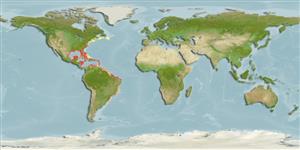Environment: milieu / climate zone / depth range / distribution range
Ecología
marino asociado a arrecife; rango de profundidad 1 - 50 m (Ref. 3790). Subtropical; 52°N - 34°S, 98°W - 34°W
Western Atlantic: Newfoundland (Canada), Bermuda, and northern Gulf of Mexico to Argentina, including the Caribbean (Ref. 3790). Eastern Atlantic.
Tamaño / Peso / Age
Maturity: Lm ? range ? - ? cm
Max length : 20.0 cm TL macho / no sexado; (Ref. 7251); common length : 10.0 cm TL macho / no sexado; (Ref. 3790)
Espinas dorsales (total): 2; Radios blandos dorsales (total): 29-37; Espinas anales 0; Radios blandos anales: 28 - 36. Snout prominently projecting but not very elongate; first dorsal spine originating above posterior part of eye; adult males with two pairs of enlarged recurved spines on each side of caudal peduncle; spines of females only slightly larger than other scale spinules of caudal peduncle (Ref. 13442).
Occurs in shallow water down to 50 m depth, over sandy and rocky bottoms, but more commonly in grass beds (Ref. 3790). Often seen moving head down among seagrass blades (Ref. 9710). The young are often associated with floating Sargassum (Ref. 3720). Feeds on plants and algae, and also on small crustaceans (Ref. 3720). Rarely consumed (Ref. 3790).
Life cycle and mating behavior
Madurez | Reproducción | Puesta | Huevos | Fecundidad | Larva
Distinct pairing (Ref. 205).
Robins, C.R. and G.C. Ray, 1986. A field guide to Atlantic coast fishes of North America. Houghton Mifflin Company, Boston, U.S.A. 354 p. (Ref. 7251)
IUCN Red List Status (Ref. 130435)
Threat to humans
Reports of ciguatera poisoning (Ref. 30303)
Human uses
Pesquerías: pesquerías de subsistencia; Acuario: Comercial
Más información
ReferenciasAcuiculturaPerfil de acuiculturaRazasGenéticaElectrophoresesheritabilidadEnfermedadesProcesamientoNutrientsMass conversion
Herramientas
Special reports
Download XML
Fuentes de Internet
Estimates based on models
Preferred temperature (Ref.
123201): 22.7 - 28, mean 25.6 °C (based on 440 cells).
Phylogenetic diversity index (Ref.
82804): PD
50 = 0.6250 [Uniqueness, from 0.5 = low to 2.0 = high].
Bayesian length-weight: a=0.01380 (0.00902 - 0.02114), b=2.87 (2.74 - 3.00), in cm total length, based on LWR estimates for this species & (Sub)family-body (Ref.
93245).
Nivel trófico (Ref.
69278): 2.7 ±0.2 se; based on diet studies.
Resiliencia (Ref.
120179): Alto, población duplicada en un tiempo mínimo inferior a 15 meses (Preliminary K or Fecundity.).
Fishing Vulnerability (Ref.
59153): Low vulnerability (10 of 100).
Nutrients (Ref.
124155): Calcium = 35.8 [14.4, 118.8] mg/100g; Iron = 0.713 [0.328, 1.784] mg/100g; Protein = 18.6 [16.3, 20.8] %; Omega3 = 0.162 [0.073, 0.328] g/100g; Selenium = 15.5 [6.4, 37.2] μg/100g; VitaminA = 38.6 [9.1, 169.8] μg/100g; Zinc = 0.952 [0.572, 1.628] mg/100g (wet weight);
